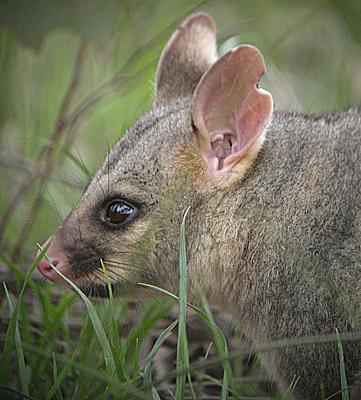Common Brushtail Possum
|
|
| Common Brushtail Possum Conservation status: Secure | ||||||||||||||||||
|---|---|---|---|---|---|---|---|---|---|---|---|---|---|---|---|---|---|---|
 | ||||||||||||||||||
| Scientific classification | ||||||||||||||||||
| ||||||||||||||||||
| Binomial name | ||||||||||||||||||
| Trichosurus vulpecula |
The Common Brushtail Possum (Trichosurus vulpecula) is the largest possum, and the most familiar of all Australian marsupials: one of the very few that thrives in cities as well as a wide range of natural and human-modified environments.
Like all possums, the Common Brushtail is nocturnal and omnivorous: in the wild it mostly eats leaves, but supplements this with fruits, flowers, buds, and whatever else is available. Common Brushtails have a notable tolerance to plant toxins; several of their favoured trees are poisonous to most creatures. Around human habitations, Common Brushtails are inventive and determined foragers with a liking for fruit trees, vegetable gardens, compost heaps and rubbish bins.
During the day Common Brushtails sleep in a nest in a hollow tree or any other convenient place, notably ceiling spaces that are not securely sealed. Although primarily aboreal and not found in places without trees to provide refuge, they spend a good deal of time on the ground.
The very loud hissing, crackling territorial call of the male Common Brushtail has a nightmare quality.
European settlers aiming to establish a fur industry introduced the Common Brushtail to New Zealand, where there are no native mammals other than bats. There are now about 60 million Common Brushtail Possums in New Zealand. Their introduction has been an ecological disaster as they do great damage to native vegetation. They also do significant harm to native wildlife by predating bird eggs and chicks and the carnivorous land snails Powelliphanta spp.
pl:Pałanka kuzu
